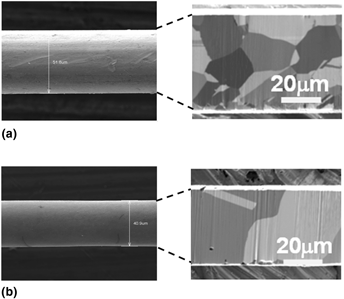Crossref Citations
This article has been cited by the following publications. This list is generated based on data provided by
Crossref.
Gan, Kefu
Gu, Rui
and
Ngan, Alfonso H.W.
2017.
The weakest size of precipitated alloys in the micro-regime: The case of duralumin.
Journal of Materials Research,
Vol. 32,
Issue. 11,
p.
2003.
Cao, Z.H.
Sun, W.
Yang, X.B.
Zhao, J.W.
Ma, Y.J.
and
Meng, X.K.
2018.
Intersectant coherent twin boundaries governed strong strain hardening behavior in nanocrystalline Cu.
International Journal of Plasticity,
Vol. 103,
Issue. ,
p.
81.
Heczel, Anita
Kawasaki, Megumi
Ugi, Dávid
Jang, Jae-il
Langdon, Terence G.
and
Gubicza, Jenő
2018.
The influence of chemical heterogeneities on the local mechanical behavior of a high-entropy alloy: A micropillar compression study.
Materials Science and Engineering: A,
Vol. 721,
Issue. ,
p.
165.
Cui, Yinan
Po, Giacomo
and
Ghoniem, Nasr
2018.
Size-Tuned Plastic Flow Localization in Irradiated Materials at the Submicron Scale.
Physical Review Letters,
Vol. 120,
Issue. 21,
Wharry, Janelle P.
Yano, Kayla H.
and
Patki, Priyam V.
2019.
Intrinsic-extrinsic size effect relationship for micromechanical tests.
Scripta Materialia,
Vol. 162,
Issue. ,
p.
63.
Zhao, Lei
Guo, Qiang
Shi, Yan
Liu, Yu
Osovski, Shmuel
Li, Zhiqiang
Xiong, Ding-Bang
Su, Yishi
and
Zhang, Di
2019.
Interfacial Effect on the Deformation Mechanism of Bulk Nanolaminated Graphene-Al Composites.
Metallurgical and Materials Transactions A,
Vol. 50,
Issue. 3,
p.
1113.
Xue, Fengmei
Lu, Haojian
and
Shen, Yajing
2019.
Scale effect investigation of copper microwire's mechanical properties after in situ scanning electron microscope twisting.
Proceedings of the Institution of Mechanical Engineers, Part C: Journal of Mechanical Engineering Science,
Vol. 233,
Issue. 10,
p.
3670.
Fu, Sichao
Yu, Dunji
Chen, Yan
An, Ke
and
Chen, Xu
2020.
Size effect in stainless steel thin wires under tension.
Materials Science and Engineering: A,
Vol. 790,
Issue. ,
p.
139686.
Warren, P. H.
Warren, G.
Dubey, M.
Burns, J.
Wu, Y. Q.
and
Wharry, J. P.
2020.
Method for Fabricating Depth-Specific TEM In Situ Tensile Bars.
JOM,
Vol. 72,
Issue. 5,
p.
2057.
Qu, Haozheng J.
Yano, Kayla H.
Patki, Priyam V.
Swenson, Matthew J.
and
Wharry, Janelle P.
2020.
Understanding plasticity in irradiated alloys through TEM in situ compression pillar tests.
Journal of Materials Research,
Vol. 35,
Issue. 8,
p.
1037.
Zhang, Yabo
Bai, Qingshun
Bai, Jinxuan
Guo, Hui
and
Cheng, Kai
2021.
Dislocation evolution in nanoscratching the CVD diamond film: Discrete dislocation dynamics simulation and experiments.
MRS Communications,
Vol. 11,
Issue. 5,
p.
619.
Huang, Song
and
Huang, Minsheng
2021.
An efficient algorithm of dislocation-precipitate interactions for single crystal nickel-based superalloys within discrete dislocation dynamics and its application.
Modelling and Simulation in Materials Science and Engineering,
Vol. 29,
Issue. 8,
p.
085003.




